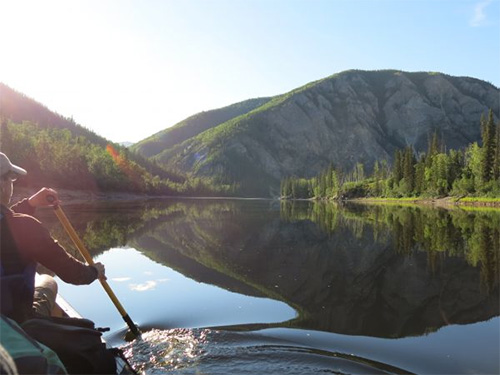
More tropical nights in Alaska’s future?By NED ROZELL
March 01, 2017
But it could happen, according to a graduate student who has tightened the grids of computer models to perhaps offer a more detailed glimpse of Alaska’s future. A tropical night is one with a low temperature of 68 degrees F or warmer. Right now, even the warmest places in Alaska hardly ever experience this. By the year 2100, the average number of tropical nights at some location in Alaska goes to 6.8. That’s according to a computer climate model run by Rick Lader. He is a graduate student at the International Arctic Research Center in Fairbanks.
A canoeist enjoys the Fortymile River on a hot summer day in 2013. Summer nights may be getting warmer in Alaska. Most global climate models predict the future of ground temperatures and other variables in 60-mile squares. Because of Alaska’s mountains and deep valleys that so affect weather and temperatures, Lader customized model results for 12-mile squares. His tweaks resulted in the ability to predict these changes for Alaska by the year 2100: • Hotter summers: The number of days with temperatures higher than 77 degrees will triple in many places across the state.Warmer winters: Winters like 2015-2016, when the temperature did not fall below minus 30 in Fairbanks, will become the norm within the next 25 years. • Higher low temperatures: The low temperature recorded in Fairbanks — minus 58 for the period of 1981 to 2010 — will be closer to minus 17 from 2071 to 2100. • More hard rains: Because warmer air can hold more moisture, Lader found intense precipitation would rise statewide by 53 percent, likely leading to increased flash flooding and landslides across Alaska. • Longer periods of rain, shorter dry spells: Consecutive days with precipitation greater than or equal to 1 millimeter will increase by 23 percent. Consecutive days of dryness will decrease 21 percent. • A longer growing season: By 2100, the annual number of days with killing frosts will decrease by two months. At the same conference where Lader presented his results, a scientist from the University of North Carolina said that aufeis in northern Alaska is disappearing sooner each summer, and fields of it are becoming smaller and less persistent. Aufeis is like a glacier in miniature that forms on streams in winter. A German term pronounced “off-icem” and meaning “ice on top,” aufeis builds all winter as groundwater forced to the surface comes in contact with frigid air and freezes in layers. Fields of aufeis can cover acres of the North Slope. Sometimes they endure the whole summer. Following through on the observations of Kirk Sweetsir, pilot for Yukon Air Service and frequent observer of northern Alaska, Tamlin Pavelsky of the University of North Carolina took a look at Alaska’s aufeis fields. He found that north of Toolik Lake, 118 of 122 large ephemeral bodies of aufeis are disappearing earlier in summer than they did in 2000. Twenty-four out of 25 aufeis fields that survive all summer long now have a smaller minimum extent than they did in 2000.
Since the late 1970s, the University of Alaska Fairbanks’ Geophysical Institute has provided this column free in cooperation with the UAF research community.
Representations of fact and opinions in comments posted are solely those of the individual posters and do not represent the opinions of Sitnews.
Stories In The News Ketchikan, Alaska
|
||
